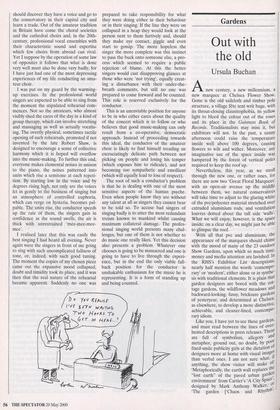Gardens
Out with the old
Ursula Buchan
Anew century, a new millennium, a new marquee at Chelsea Flower Show. Gone is the old sailcloth and timber pole structure, a village fête tent writ huge, with its throat-closing claustrophobia, its yellow light to bleed the colour out of the roses and its place in the Guinness Book of Records. Traditionalists may miss it, but exhibitors will not. In the past, a sunny afternoon could raise the temperature inside well above 100 degrees, causing flowers to wilt and wither. Moreover, any imaginative use of the space inside was hampered by the forest of vertical poles required to keep the roof up, Nevertheless, this year, as we stroll through the new one, or rather ones, for there are now two 'Great Floral Marquees' with an open-air avenue up the middle between them, we natural conservatives will take time to adjust to the glaring white of the pvc/polyester material stretched over extruded aluminium rods, and ventilation louvres dotted about the tall side 'walls'. What we will enjoy, however, is the space inside; on a clear day, we might just be able to glimpse the roof. With all that pvc and aluminium, the appearance of the marquees should chime with the mood of many of the 23 outdoor Show Gardens, upon which so much time, money and media attention are lavished. In the RHS's Exhibitor List descriptions, nearly half mention the words 'contempo- rary' or 'modern', either alone or in synth sis with traditional elements. It is plain that garden designers are bored with the cot- tage gardens, the wildflower meadows and backward-looking, fussy, bricksure gardens of yesteryear, and determined at Chelsea, as elsewhere, to develop a more distinctive, achievable, and cleaner-lined, contempo- rary idiom. Like you, I have yet to see these gardens' and must read between the lines of over- heated descriptions in press releases. These are full of symbolism, allegory all' metaphor, ground out, no doubt, by poor, fixed-smile publicity girls at the dictation (n designers more at home with visual irnage,s than verbal ones. I am not sure what, n anything, the show visitor will make of.. `Metaphorically, the earth wall replaces the "lost earth" of the paved urban garden, environment' from Cartier's 'A City Space ' designed by Mark Anthony Walker, 1:)- `The garden ['Chaos and Rhythm' designed by Dr Claire Whitehouse for Ban's City Lifesaver project] symbolises the chaotic rhythm of the heart during a cardiac arrest and the restoration of order once the heart has been successfully shocked with early defibrillation.' I rather wonder, too, whether we punters will get the finer points of the Prince's Trust gar- den, an allegory for the development of a young person who sets up a business with the PBT (Prince's Business Trust): 'The entrance is through a sculptured arch with a small pool which produces ripples indi- cating the start of an idea. . . . A second pool overflows down the face of a copper Wall and is re-circulated back to the entrance (the journey is cyclical, indicating constant review and development).' Most Perplexing is the courtyard garden from West Oxfordshire College, called `The Essence of Life', which is 'an attempt to recreate with leaf forms an underwater environment reminiscent of coral reefs and ocean depths, with flashes of brilliant colour provided by flowers. A patio echoes the shape of a Nautilus shell . . . ' Somewhere, amongst all this flummery, are innovative ideas, particularly on the handling of spaces, which deserve a public airing. My guess is that the stars of Chelsea 2000 will be: the Evening Standard's 'Gar- den for all Time', by Arabella Lennox- Boyd whose Chelsea swansong this is; 'The Living Sculpture Garden', created for the Daily Telegraph by Christopher Bradley- Hole; 'Evolution' by Arne Maynard and Piet Oudolf for Gardens Illustrated; and Ryl Nowell's `Gardens Sans Frontieres'. From these four, I confidently expect lively, thoughtful planting schemes to enhance, rather than do battle with; uncluttered, classy hard landscaping. The Design and Landscape Centre's Mondrian-influenced parterre, part-plant- ed, part-gemstone gravel, by Colin Elliott, and Stephen Woodhams's two minimalist gardens for Marks & Spencer are also like- ly to prove interesting, though plants may feature less. And, for its sheer exuberant chutzpah, there will be no beating Paul Co nper's 'Flying Garden' (for QualCraft) with its 27 airborne planters. On the traditional side, if past form is anything to go by, Michael Upward's Magic of the Mountains' garden for the Alpine Garden Society will be brilliantly Planted, whilst Patrick McCann's `Sun Awareness Garden' for Marie Curie Can- cer Care will be worthy and well-executed, and His Highness Shaikh Zayed bin Sultan 2,,',"Nahyan's 'Garden of the Night' by tasteful`--11 a de s Funke Associates is bound to be e in the extreme, with white, tender Plants inside a boundary of Dawn Red- woods, At the same time, Jeff Groundrill and the inmates of HMP Leyhill will demonstrate once again the resilience of the human spirit in 'Time the Healer', of all the Chelsea gardens the one where a devotion to symbolism can be most readily forgiven. Any natural conservatives who find themselves stomping around the show- ground in a furious bate about the new marquees should find solace in front of the `Homage to Le Mitre' garden, designed by Tom Stuart-Smith for Harpers & Queen and the Garden History Society, to mark the 300th anniversary of the death of Louis XIV's great gardener. The acceptable face of backward-looking, you might say.










































































 Previous page
Previous page